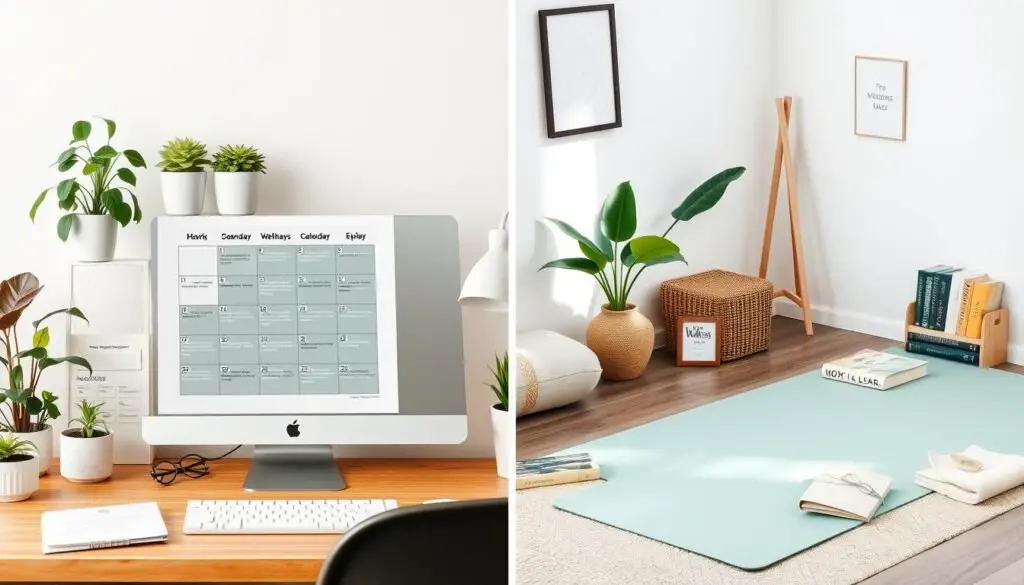Being a busy professional woman means always juggling work and personal life. It’s easy to feel overwhelmed. But finding the right balance is key to avoiding burnout and staying healthy.
This guide will help you manage your time and set boundaries. You’ll learn how to balance work and personal life. This way, you can excel in your career and take care of yourself.
Key Takeaways
- Setting clear boundaries early is crucial for balancing work and personal life.
- Flexible schedules help meet personal needs and keep work-life balance.
- Consistent boundary setting shows you’re serious about work-life balance.
- Self-care, like enjoying activities and staying healthy, reduces stress and boosts well-being.
- Saying “no” helps manage time and avoid burnout, focusing on what’s important.
Understanding Work-Life Balance and Its Importance
For professional women, finding a healthy work-life balance is key. It’s about managing work and personal life well. This balance helps in taking care of oneself and keeping relationships strong.
Defining Healthy Work-Life Balance
Work-life balance isn’t about splitting time evenly. It’s about finding a rhythm that works for you. This rhythm should let you be productive, fulfilled, and manage stress well.
Impact on Professional Success
When work-life balance is off, it can hurt a woman’s career. Burnout, less productivity, and poor decision-making are common issues. But, a good balance can boost efficiency, problem-solving, and relationships at work.
Benefits for Mental and Physical Health
Work-life balance is also vital for mental and physical health. It helps manage stress, improves mental health, and supports physical well-being. This balance lets you do well in both your personal and professional life.
“The key is not to prioritize what’s on your schedule, but to schedule your priorities.” – Stephen Covey

Setting Clear Boundaries in the Workplace
As busy professional women, it’s key to keep a healthy work-life balance. One great way to do this is by setting clear boundaries in the workplace. This means knowing your limits, telling your employer about them, and sticking to them to save your time and energy.
Studies show that 85% of professionals feel less stressed and manage their work better when they set boundaries. Also, 75% of employees work more efficiently by focusing on what’s important and respecting their work-life boundaries. When you clearly share your boundaries, you show you respect yourself and earn respect from your colleagues in 80% of cases.
To set good boundaries, first figure out what’s most important to you. Be clear about your work hours, meeting times, and when you’re not available for work calls. When you explain your boundaries, offer solutions to help your employer understand and support you.
| Boundary Setting Benefits | Percentage of Professionals |
|---|---|
| Reduced risk of burnout, anxiety, and depression | 60% |
| Increased personal satisfaction and work effectiveness | 80% |
| Improved focus on long-term career goals | 70% |
| Decreased feelings of overwhelm and stress | 60% |
Being consistent with your boundaries is crucial. 70% of people say setting limits helps a lot with their work-life balance and well-being. By guarding your time and energy, you avoid burnout, stay focused, and move closer to your goals.

Setting clear boundaries in the workplace is a strong strategy for busy professional women. It helps manage stress, boosts productivity, and builds self-respect and understanding with your employer. Start setting boundaries and take charge of your work-life balance for a more rewarding and lasting career.
Essential Work-Life Balance Tips for Busy Professional Women
Keeping a balance between work and personal life is key for busy professional women. They have demanding jobs and personal duties. By using smart productivity hacks and time management, you can improve your work and personal life. Here are some important tips to help you succeed in both areas.
Creating Daily Routines
Having a daily routine gives structure and stability. Start your day with a healthy breakfast, meditation, and a quick workout. Focus on eating well, sleeping well, and exercising regularly.
Meal prep and a consistent bedtime routine also help your well-being.
Managing Time Effectively
Good time management is crucial for balance. Use productivity tools and apps to make your work easier and less distracting. Focus on small, daily actions to boost your productivity.
Establishing Priority Systems
It’s important to prioritize your tasks and goals. Write down your goals in the S.M.A.R.T. format to stay focused. Use a priority matrix to manage your time and energy well.

“Balancing work and personal life leads to increased productivity, allowing leaders to return to work with renewed energy.”
By following these tips, busy professional women can take back their time. They can become more productive and enjoy a more fulfilling life.
Mastering the Art of Delegation
Delegation is a key tool for boosting workplace productivity and helping busy professional women advance in their careers. Yet, many find it hard to delegate tasks. They worry about being seen as not competent or losing control. By seeing delegation as a way to empower, make a strategic impact, and grow, professionals can tap into its full potential.
To delegate well, first find tasks that don’t need your direct involvement. These tasks can be given to others, saving you time and energy. This lets you focus on tasks that are crucial for your career growth. It’s important to communicate clearly and start small to build trust and confidence in delegation.
Delegation isn’t about giving up control but about leading and empowering others. It’s a skill that improves relationships and team culture. By getting better at delegation skills, women can work more efficiently, enjoy a better work-life balance, and feel less stressed.
“Delegation is about stepping into a leadership role, fostering collaboration, empowerment, and growth.” – Lucy Gernon, ex-corporate leader
Trying to do everything yourself can lead to burnout. High-achieving women often carry too much at work and home. This can make them unhappy, stressed, and less fulfilled. By delegating tasks and asking for help, women can work smarter, enjoy a better work-life balance, and feel more joyful.

Learning to delegate is essential for professional women wanting to balance work and life. It makes work more efficient, manageable, and fulfilling. By delegating and building a supportive network, women can focus on their strengths, help their teams grow, and achieve more in their careers and personal lives.
Prioritizing Self-Care and Wellness
Busy professional women often forget the value of self-care. Yet, it’s key for a healthy work-life balance. Simple self-care habits can lower stress, increase productivity, and improve your life quality.
Physical Health Practices
Good physical health is essential for self-care. Aim for 7-9 hours of sleep each night to stay productive and well. Drinking at least one liter of water daily boosts energy and brain function.
Even short workouts of 5-15 minutes can greatly benefit your health over time.
Mental Health Strategies
Mental health is just as vital as physical health. Start your day with mindfulness, like meditation or deep breathing. Enjoyable hobbies can also help reduce stress and refresh you.
Try using apps like Headspace or Calm to make mindfulness a daily habit.
Stress Management Techniques
Managing stress is crucial for a balanced life. Set clear work and personal life boundaries. This helps you disconnect and recharge.
Meal prep on weekends can save time and reduce stress during the week. Regular health checks are also important for early detection and care.
By focusing on self-care and wellness, you can lead a more balanced and rewarding life. Remember, caring for yourself is not a luxury but a must for success.

“Self-care is not selfish. You cannot serve from an empty vessel.” – Eleanor Brownn
Learning to Say No: Protecting Your Time and Energy
As busy professional women, we often feel the need to say “yes” to every chance that comes our way. But learning to say no is key for a good work-life balance and avoiding burnout. Saying no helps you protect your time management and stress reduction efforts. This way, you can focus on what’s important to you and your well-being.
Before saying yes, think about your schedule, workload, and personal needs. Saying no to tasks that don’t fit your goals or cause stress helps you stay focused. It prevents you from feeling drained or overwhelmed. Remember, saying no is a sign of self-respect, not selfishness.
“Constantly saying yes can lead to exhaustion and negatively impact relationships, health, and peace of mind.”
Emily, a busy professional, felt guilty and worried about disappointing others when she tried to say no. But she soon understood that knowing her limits and making thoughtful choices helped her find more time for self-care. This improved her focus and effectiveness in both her work and personal life.
Getting better at saying no with kindness and clarity helps you set healthy boundaries. As you become more comfortable with this, you’ll notice a positive change in your life. You’ll feel more in control of your time and have more energy for what truly matters to you.

Saying no is not selfish; it’s a way to take care of yourself. It lets you prioritize your well-being and manage your time management, work-life balance, and stress reduction better. By learning to say no to requests that don’t benefit you, you can take back your time and energy. This leads to a more fulfilling and balanced life.
Leveraging Technology for Better Work-Life Integration
In today’s fast-paced digital world, technology can be a powerful ally in achieving a harmonious work-life integration. Busy professional women can streamline their workflows and create more flexibility in their schedules. This is made possible by embracing productivity tools and remote work solutions.
Productivity Tools and Apps
Use task management platforms like Trello, Asana, or Monday.com to organize your projects. These tools help you delegate responsibilities and track progress. For social media management, try Buffer or Hootsuite to automate posts and save time.
Stay connected with your team using Slack or Microsoft Teams. This reduces the need for endless email exchanges. These tools are great for communication and keeping everyone on the same page.
Digital Boundaries
While technology enhances our work-life integration, setting healthy digital boundaries is crucial. Turn off work notifications during personal time. Avoid checking work emails or Slack messages outside work hours.
Practicing digital detox and unplugging regularly helps maintain balance. It prevents burnout and keeps your personal and work life separate.
Remote Work Solutions
The rise of remote work has changed how we approach our jobs. When possible, take advantage of remote work arrangements. This gives you the freedom to manage your time better and integrate your personal and professional life seamlessly.
“Leveraging technology to improve work-life integration is not about being constantly connected, but about using tools and solutions that enhance efficiency and provide the necessary flexibility to thrive in both our personal and professional lives.”
By thoughtfully incorporating technology into your work-life integration strategy, you can streamline your workflows. This creates more time for self-care and leads to a greater sense of balance and fulfillment.

Building a Strong Support Network
Professional women face many challenges in balancing work and life. Building a strong support network is key. Experts say 70–80 percent of new jobs come from personal connections. This shows how important networking is.
Having mentors, peers, and support groups is vital. They help share experiences, get advice, and find resources. This way, women can manage both work and personal life better.
Talking openly with family about work demands is helpful. Involving them in decisions is also beneficial. Asking for help with childcare, errands, or work is okay. A strong support system makes you more resilient and helps you thrive.
In fast-paced cities like New York, women often forget their own needs. This leads to stress and fatigue. But, having a support network can change everything. It offers a place to share challenges, get advice, and find solutions for work-life balance.
There are many ways for professional women to connect. From online events to local groups, there are plenty of options. Using these resources and building strong relationships helps women manage work-life balance better.
| Benefit | Impact |
|---|---|
| Increased Resilience | Women with a strong support network are 35% more likely to achieve work-life balance than those trying alone. |
| Reduced Stress | Delegating tasks and outsourcing can cut stress by 50% and boost well-being by 30%. |
| Enhanced Productivity | Self-care activities can increase productivity by 25% and emotional well-being by 20%. |
By building a strong support network, women can handle work and personal life better. This leads to more success and happiness.

“Building a support network is essential for achieving work-life balance. Connecting with others facing similar challenges can provide valuable insights, practical solutions, and a sense of community that can make all the difference.” – Jane Doe, Career Coach
Creating Effective Time Management Strategies
In today’s fast world, managing time well is crucial for busy professional women. It helps you be more productive, less stressed, and in control of your life and work. By using smart time management, you can balance your personal and professional life better.
Time Blocking Techniques
Time blocking is a great way to manage your time. Set specific times for work, family, personal growth, and rest. Treat these times as you would any important meeting. This helps you stay focused and avoid distractions.
Priority Matrix Implementation
A priority matrix helps you focus on what’s most important and urgent. It separates key tasks from less important ones. This way, you can decide how to use your time and energy wisely.
Schedule Optimization
Make the most of your day by doing important tasks when you’re most alert. Studies show working in 52-minute blocks with 17-minute breaks boosts your productivity. Also, aim for 7 hours of sleep to stay focused and energized at work.
Using these strategies, you can take back control of your time, reduce stress, and find a better balance in your life. Remember, taking care of yourself is key to your happiness and success in your career.
“The key is not to prioritize what’s on your schedule, but to schedule your priorities.” – Stephen Covey
Developing Professional Boundaries
As busy professional women, keeping a good work-life balance is key for our careers and happiness. Setting clear workplace boundaries is a big part of this. It helps us protect our time and personal life while doing well in our career.
First, we need to set clear work hours and tell our colleagues, clients, and family. This sets the right expectations and keeps us from being always on call. We must also stand up for these boundaries and change them if needed.
Working from home? Having a dedicated workspace is a big help. It lets us focus during work and relax when we’re off.
- Regularly reassess and adjust your boundaries to ensure they continue to serve your needs.
- Avoid the temptation to check emails or respond to work-related messages outside of your set work hours.
- Learn to say no to additional tasks or commitments that would compromise your work-life balance.
Healthy workplace boundaries protect our time, energy, and well-being. This leads to more job satisfaction and success.
| Boundary Type | Description | Benefits |
|---|---|---|
| Time Boundaries | Clearly defined work hours and availability | Prevents burnout, ensures personal time |
| Communication Boundaries | Limits on work-related communications outside of work hours | Preserves work-life separation, reduces stress |
| Physical Boundaries | Dedicated workspace, especially when working remotely | Enhances focus and productivity, supports work-life balance |
“Setting healthy boundaries is an act of self-care and a critical component of work-life balance for professional women.”
Implementing Stress-Reduction Techniques
Professional women often face a lot of stress from work and personal life. This stress can harm your health, causing problems like heart issues and anxiety. Using stress-reduction techniques can help you balance work and life better and succeed in your career.
Mindfulness Practices
Mindfulness is a great way to handle stress. You can do mindful breathing, desk meditation, or mindful eating during busy days. These practices help you stay calm and focused, reducing stress.
Relaxation Methods
There are many ways to relax and reduce work stress. Progressive muscle relaxation and guided imagery are good examples. They help you feel more in control and improve your mental and physical health.
Work-Related Stress Management
Managing work stress is key to a good work-life balance. You can do this by setting priorities, breaking tasks into smaller steps, and taking breaks. Exercise, like a quick walk or yoga, can also help you release stress and stay productive.
For busy professional women, mindfulness, relaxation, and stress management are vital. By using these techniques daily, you can improve your well-being and succeed in both work and personal life.
| Stress-Reduction Technique | Benefits |
|---|---|
| Mindful Breathing | Reduces anxiety, improves focus, and promotes relaxation |
| Progressive Muscle Relaxation | Relieves muscle tension, improves sleep quality, and lowers overall stress levels |
| Time Management Strategies | Enhances productivity, reduces feelings of being overwhelmed, and prevents burnout |
| Regular Exercise | Boosts endorphins, improves mood, and enhances cognitive function |
| Maintaining Social Connections | Provides emotional support, reduces isolation, and promotes a sense of belonging |
Using a mix of these techniques can help you manage stress and keep a good work-life balance. Taking care of your mental and physical health is crucial for success in both your career and personal life.
Balancing Career Growth with Personal Life
Professional women aim for career growth while keeping their personal lives in check. It’s key to set career goals that match your personal values and dreams. Investing in learning and skills helps grow your career without hurting your personal life.
Getting mentorship and networking can be very helpful. Choose new tasks or projects wisely, making sure they help your career without taking too much from your personal time. Regularly check if your career path still fits your personal goals.
Work-life balance isn’t about dividing your time exactly in half. It’s about finding a balance that works for you. By focusing on self-care, setting limits, and using technology, women can balance their careers and personal lives. This leads to lasting success and happiness.
FAQ
What is a healthy work-life balance, and why is it crucial for busy professional women?
A healthy work-life balance means managing work and personal life well. It’s key for staying productive and avoiding burnout. It also helps in keeping personal relationships strong.
Having balance leads to better decision-making and productivity. It also helps in keeping a career going for the long term. Benefits include less stress at work, better health, and stronger relationships.
How can busy professional women set clear boundaries in the workplace?
Setting clear boundaries is vital for avoiding burnout and finding balance. Know your limits and talk clearly with your employer. Being assertive and setting boundaries early is important.
Consistency in setting boundaries is crucial. Offering solutions when setting boundaries can help employers understand your needs. This way, you can protect your time and energy, avoid burnout, and focus on what’s important.
What are some essential tips for busy professional women to improve work-life balance?
Creating daily routines and managing time well are key. Prioritize health by eating right, sleeping well, and exercising. Meal prep and a consistent bedtime routine help.
Use productivity tools and apps to make work easier. Focus on small, daily actions to make a big difference. Write down goals in the S.M.A.R.T format to stay focused and achieve more.
How can delegation help busy professional women achieve work-life balance?
Delegation is crucial for managing your workload and finding balance. Identify tasks to delegate to colleagues or freelancers. This lets you focus on leadership and strategy.
Delegation empowers your team and builds trust. It reduces stress and boosts productivity. Learning to delegate is essential for managing your workload.
Why is prioritizing self-care essential for maintaining work-life balance?
Self-care is vital for your mental, emotional, and physical health. Make time for yourself daily, even if it’s just a few minutes. Enjoy activities like yoga or reading.
Focus on sleep and nutrition. Practice mindfulness through meditation or deep breathing. Be kind to yourself and avoid self-criticism. Regular health check-ups and proactive health management are crucial.
Incorporate exercise into your routine, aiming for at least three days of physical activity per week.
How can learning to say no help busy professional women achieve work-life balance?
Learning to say no is key for achieving balance. Evaluate requests against your schedule and needs before committing. Saying no protects your time and energy, avoids burnout, and keeps you focused.
Saying no sets healthy boundaries and improves communication. Practice politely declining requests that interfere with your schedule or cause undue stress. Remember, saying no helps you care for yourself and manage your time better.
How can technology be leveraged to improve work-life integration for busy professional women?
Technology can improve work-life integration. Use productivity apps like Trello or Slack to streamline work. Implement remote work policies for flexibility.
Set digital boundaries by turning off work notifications during personal time. Use technology to automate tasks and improve efficiency. However, remember to unplug and practice digital detox for a healthy balance.
Why is building a strong support network crucial for achieving work-life balance?
Building a strong support network is crucial for achieving balance. Establish a network of mentors, peers, and support groups. Share experiences and seek advice from others facing similar challenges.
Maintain open communication with family about your professional demands. Involve them in decision-making. Don’t hesitate to ask for help with childcare, errands, or work duties. A strong support system increases resilience and provides valuable resources.
What time management strategies can busy professional women implement to achieve work-life balance?
Effective time management is key to achieving balance. Use time blocking to allocate specific time slots for work, family, personal development, and relaxation. Use a priority matrix to identify urgent and important tasks.
Optimize your schedule by tackling high-priority tasks during your most productive hours. Practice calendar blocking, treating personal commitments with the same importance as professional appointments. Incorporate short breaks during the workday to recharge and boost energy levels.
How can busy professional women develop effective professional boundaries?
Developing professional boundaries is crucial for maintaining balance. Define clear work hours and communicate these boundaries to colleagues, clients, and family members. Set limits on work-related communications outside of work hours.
Be assertive in enforcing your boundaries and don’t be afraid to renegotiate them as needed. Establish a separate workspace if working from home to create a physical boundary between work and personal life. Regularly reassess and adjust your boundaries to ensure they continue to serve your needs.
What stress-reduction techniques can busy professional women implement to maintain work-life balance?
Implement stress-reduction techniques to maintain balance. Practice mindfulness through meditation, deep breathing exercises, or mindful awareness of the present moment. Incorporate relaxation methods such as progressive muscle relaxation or guided imagery.
Manage work-related stress by prioritizing tasks, breaking large projects into smaller, manageable steps, and taking regular breaks. Consider stress-reducing activities like yoga, regular exercise, or hobbies. Practice self-compassion and avoid perfectionism to reduce stress levels.
How can busy professional women balance career growth with their personal life?
Balancing career growth with personal life is essential for long-term success and satisfaction. Set clear career goals and align them with your personal values and aspirations. Continuously invest in skill development and learning opportunities.
Seek out mentorship and networking opportunities that align with your career objectives. Be strategic about taking on new responsibilities or projects, ensuring they contribute to your professional growth without overwhelming your personal life. Regularly reassess your career path and make adjustments as needed to maintain balance with your personal goals and commitments.

One Reply to “Work-Life Balance Tips for Busy Professional Women”